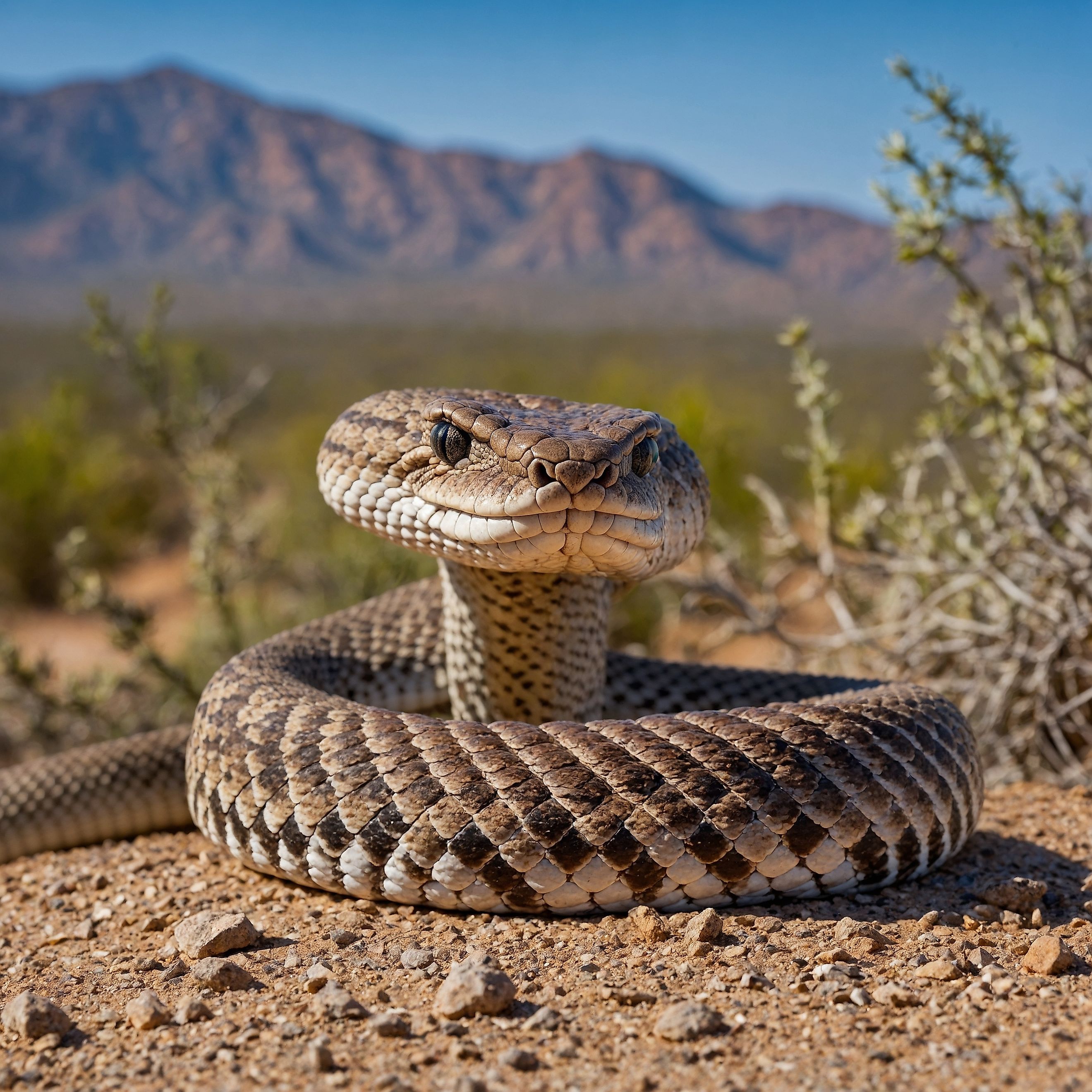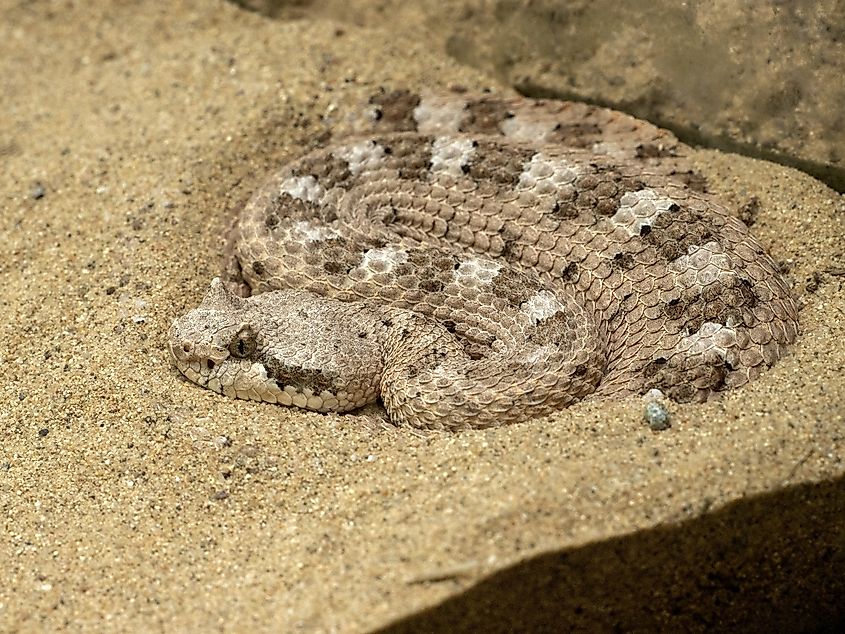
The Venomous Snakes Of Arizona
Arizona, with its ideal climate and diverse habitats, is home to 19 of the country’s 20 venomous snake species, making it the state with the highest number of venomous snakes in the US. While most of these snakes will avoid humans, a venomous snake bite, though rarely life-threatening, still requires immediate medical attention. While states like Texas and Florida are often associated with snakes, Arizona’s unique range of environments—from nocturnal hunters to sun-loving climbers—make it a hotspot for these dangerous creatures. Here, we'll explore six of Arizona's most venomous snakes.
Animas Ridgenose Rattlesnake

This federally protected species of rattlesnake was photographed in the Peloncillo mountains of the Arizona and New Mexico border.
The Animas Ridgenose rattlesnake, Crotalus willard obscurus, is a smaller snake native to Arizona and New Mexico. On average these rattlesnakes grow to be roughly 18 inches in length and rarely exceed 2 feet. The body of the Animas Ridgenose rattlesnake ranges from greyish beige to reddish brown in color with small white bands lining the body. The name “Ridgenose” comes from one of the snake’s defining facial features-a small, upturned ridge above the nostrils.
As a part of the viper family of snakes, the Animas Ridgenose is venomous. However, their venom tends to be quite mild and non-life threatening. Humans are mostly likely to spot an Animas Ridgenose rattlesnake during the day as they are a diurnal species. The snakes also prefer a high-elevation habitat and are most commonly found in wooded mountain areas including The Peloncillo Mountains of Hidalgo County. Like most rattlesnakes, the Animas Ridgenose opts for an “ambush predation” hunting method, laying in wait until a small rodent or unsuspecting lizard crosses its path.
Western Diamondback Rattlesnake

Western Diamondback coiled, tail rattling, tongue out.
As the largest type of rattlesnake in the Western US, the Western diamondback rattlesnake can look a bit intimidating at first glance. The snakes, Crotalus atrox, have a thick body and can grow up to 8 feet long. However, they typically fall between 3 to 5 feet long. Western diamondback’s coloring varies from light brown to grey and sometimes pink or olive tones, depending on their environment. As the name implies, the snake bodies also feature a distinct diamond pattern along their spines. Near the base of the tail, this diamond pattern typically changes into black rings that lead to the rattle on the end. They also have dark stripes running down the side of either cheek.
In addition to Arizona, the Western diamondback can also be spotted in Arkansas, California, New Mexico, Oklahoma, and Texas. Like many snakes in the viper family, the Western diamondback has a heat-sensing mechanism located behind its nostrils. This mechanism helps the snake detect nearby prey which includes rodents, small rabbits, lizards, and various ground-dwelling birds. Unlike the Animas Ridgenose rattlesnake which prefers a mountain habitat, the Western diamondback resides in areas along the coast, forests, deserts, rocky hillsides, and grassy plains.
Sonoran Desert Sidewinder

The Sonoran desert sidewinder, Crotalus cerastes cercobombus, features a distinctive feature: two large, upturned scales on its head which look like horns. Because of said “horns,” the snake is also commonly called the “horned rattlesnake.” The snake is also known for its unusual sideways movement that leaves small “J” patterns in the sand. This sideways movement helps limit the snake’s contact with the sand, keeping it from overheating.
As a primarily nocturnal snake, the Sonoran desert sidewinder often hunts at night, burying itself in the sand for camouflage. The snake's diet consists of lizards, rodents, and occasionally other smaller snakes. Because sand is so vital to the hunting process, you will often find the horned rattlesnake in arid sand flats, sand dunes, and vast desert shrublands.
Arizona Coral Snake

The Arizona coral snake (micruroides euryxanthus).
Easily identifiable by its bold color pallet, the Arizona coral snake is a sneaky nighttime hunter that primarily munches “on blind and black-headed snakes,” according to the Arizona-Sorano Desert Museum. Also referred to by its scientific name, Micruroides euryxanthus, the coral snake’s body is covered in a pattern of thick red, yellow, and black bands. The yellow stripes can often appear faded, making them look almost white. There are a handful of other, nonvenomous snakes with similar coloration. An easy way to tell the difference between coral snakes and their non-venomous look-alikes: Red touches yellow-kill a fellow or red touches black-venom lack. Essentially, the snake is venomous if the yellow and red stripes are touching.
As for their habitat, the Arizona coral snake resides mostly among desert scrubs. They can also be found in woodlands, grasslands, and farmlands. Another defining feature of the coral snake is the fixed, not hinged, fangs at the front of their mouth.
Mojave Desert Sidewinder

a Crotalus cerastes sidewinder horned rattlesnake viper close up on the the sand with open blue eyes.
Coming in at approximately 2 feet long, the Mojave desert sidewinder is a venomous snake in the pit viper family. In addition to Arizona, this snake breed can also be spotted in California, Nevada, and Utah. Like many of the snakes on this list, the Mojave desert sidewinder, Crotalus cerastes, is typically beige or cream-colored. In addition to body color, it shares a handful of similarities with the Sonoran desert sidewinder specifically. For example, both sidewinders have raised horn-like scales above the eyes and a distinct sideways motion that creates a “J” pattern in the sand.
Other characteristics of this snake's appearance include cat-like eyes, a black-tipped rattle at the end of the tail, and splotchy brownish markings along the skin. The preferred habitat for the Mojave desert sidewinder is sandy desert scapes where there are plenty of rodents and lizards to snack on.
Northern Black-tailed Rattlesnake

Northern Black-tailed Rattlesnake with Tongue Out in Arizona Desert.
The Northern black-tailed rattlesnake, Crotalus molossus, grows up to 4 feet long and has a greenish, yellow, or grey body and a dark brown head. Dark brown, nearly black irregular blotches create a beautiful pattern on the snake’s skin as well. The snake's tail is entirely black, as the name suggests, and has the typical rattle on the end.
This black-tailed rattlesnake can be found in a variety of habitats including grasslands, deserts, rocky areas, and high-pine or boreal forests. Its diet consists mostly of small rabbits and squirrels, but they will occasionally eat other snakes and lizards as well. One of the most interesting facts about the Northern black-tailed rattlesnake is its climbing ability. These snakes have been observed sunning themselves over 8 feet above the ground.
Conclusion
While Arizona’s venomous snakes are certainly a concern, they play an important role in the ecosystem by controlling populations of small mammals and pests. By understanding the behavior and habitats of these snakes, you can minimize the risk of encounters and stay safe while enjoying the state's natural beauty. Remember, most venomous snakes prefer to avoid humans, and bites are rare, but always exercise caution and seek immediate medical attention if bitten. With proper awareness, you can safely appreciate the incredible diversity of wildlife Arizona has to offer.











